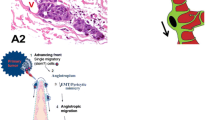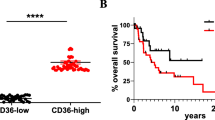Abstract
Melanoma cells but not normal melanocytes share important cell surface molecules with endothelial cells. From this observation has grown our hypothesis that melanoma and endothelial cells use the same cell surface molecules for invasion but that their intracellular signaling is different allowing the malignant cells dominance over the normal cells. Stromal fibroblasts and endothelial cells communicate with metastatic cells through an interactive network of cell–cell and cell–matrix signaling. Fibroblasts induce capillary-like differentiation of microvascular endothelial cell monolayers through cell–cell contact and soluble factors. It is then hypothesized that normal cellular precursors are recruited from the bone marrow to the site of a growing melanoma metastasis. Thus pathways for angiogenesis and vasculogenesis are guided through the cooperation of fibroblasts and melanoma cells perpetuated by the dominance of the metastatic melanoma cells.
Similar content being viewed by others
Author information
Authors and Affiliations
Corresponding author
Rights and permissions
About this article
Cite this article
Velazquez, O.C., Herlyn, M. The vascular phenotype of melanoma metastasis. Clin Exp Metastasis 20, 229–235 (2003). https://doi.org/10.1023/A:1022987201264
Issue Date:
DOI: https://doi.org/10.1023/A:1022987201264




